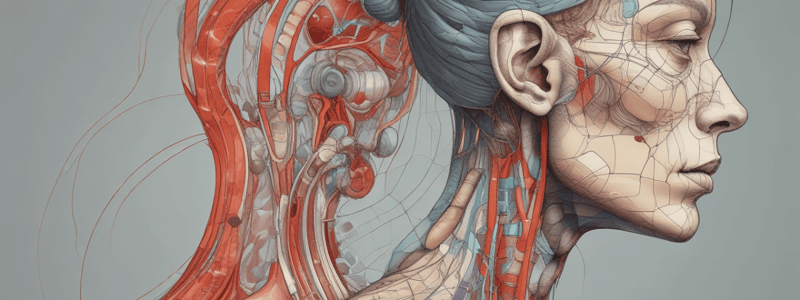Podcast
Questions and Answers
Which type of sensory receptor is involved in detecting deep pressure and vibration?
Which type of sensory receptor is involved in detecting deep pressure and vibration?
- Meissner corpuscles
- Pacinian corpuscles (correct)
- Merkel discs
- Free nerve endings
Where are eccrine sweat glands most numerous?
Where are eccrine sweat glands most numerous?
- Groin and armpits
- Forehead, palms, and soles (correct)
- Nose and ears
- Scalp and back
Which substance do sebaceous glands secrete?
Which substance do sebaceous glands secrete?
- Cerumen
- Sweat
- Melanin
- Sebum (correct)
Where is hair not present on the human body?
Where is hair not present on the human body?
Which phase is NOT a part of deep wound healing?
Which phase is NOT a part of deep wound healing?
What is the main function of ceruminous glands?
What is the main function of ceruminous glands?
What is the primary function of nails?
What is the primary function of nails?
Which is NOT a cause of burns?
Which is NOT a cause of burns?
Which type of cell in the epidermis produces keratin?
Which type of cell in the epidermis produces keratin?
What is the primary function of Langerhans cells in the epidermis?
What is the primary function of Langerhans cells in the epidermis?
Which layer of the epidermis is only present in thick skin?
Which layer of the epidermis is only present in thick skin?
What is the function of the lamellar granules released in the stratum granulosum?
What is the function of the lamellar granules released in the stratum granulosum?
Which type of skin has five layers including the stratum lucidum?
Which type of skin has five layers including the stratum lucidum?
What type of tissue primarily composes the dermis?
What type of tissue primarily composes the dermis?
What pigment do melanocytes produce that dictates skin colour?
What pigment do melanocytes produce that dictates skin colour?
What is a characteristic of albinism?
What is a characteristic of albinism?
Flashcards are hidden until you start studying
Study Notes
Sensory Receptors
- Differentiate between tactile sensations: light touch, pressure, vibration, itch, and tickle
- Superficial receptors: Merkel discs, free nerve endings, Meissner corpuscles, hair root plexuses
- Deep receptors: Pacinian corpuscles
Hair
- Found on most surfaces except palms, anterior surfaces of fingers, and soles of feet
- Composed of dead, keratinized epidermal cells
- Helps with touch sensations and protects against sun and heat loss
- Hair color determined by amount and type of melanin
Exocrine Skin Glands
Sebaceous (Oil) Glands
- Connected to hair follicles
- Secrete sebum, preventing dehydration and inhibiting bacteria
Sudoriferous (Sweat) Glands
Eccrine Sweat Glands
- Most numerous on forehead, palms, and soles
- Secrete watery solution (600 ml/day) to cool body and eliminate waste
Apocrine Sweat Glands
- Found in skin of axilla, groin, areolae, and bearded regions of face
- Secrete milky viscous sweat responsible for body odor
Ceruminous Glands
- Modified sweat glands in ear canal
- Produce cerumen (earwax)
Nails
- Protect distal end of digits
- Provide support and counterpressure for touch perception and manipulation
- Allow grasping and manipulation of small objects, and used for scratching and grooming
Wound Healing
Epidermal Wound Healing
- Occurs in superficial wounds affecting only epidermis
- Repairs skin to normal structure and function
Deep Wound Healing
- Occurs in injuries extending to dermis and subcutaneous layer
- Results in loss of function and development of scar tissue
- Healing process involves four phases: inflammatory, migratory, proliferative, and maturation
Burns
- Tissue damage caused by denaturation of skin cell proteins by excessive heat, electricity, radiation, or corrosive chemicals
Integumentary System
The Epidermis
- Composed of keratinized stratified squamous epithelium
- Contains four major cell types: keratinocytes, melanocytes, Langerhans cells, and Merkel cells
Layers of Epidermis
- Stratum corneum: 25 layers of flat dead keratinocytes
- Stratum lucidum: present in thick skin, 4-6 layers of dead keratinocytes
- Stratum granulosum: 3-5 layers of flattened keratinocytes undergoing apoptosis
- Stratum spinosum: layers of 8-10 keratinocytes
- Stratum basale: cuboidal or columnar keratinocytes
Types of Skin
- Thin (hairy) skin: covers all body regions except palms, palmar surfaces of digits, and soles
- Thick (hairless) skin: covers palms, palmar surfaces of digits, and soles
The Dermis
- Provides temperature stability and prevents dehydration
- Composed of dense irregular connective tissue containing collagen and elastic fibers
- Contains two regions: papillary and reticular regions
Skin Pigments
- Melanin: produced by melanocytes in stratum basale, dictates skin color
- Eumelanin: brown/black polymer
- Pheomelanin: yellow/red polymer
- Nevi: chronic benign lesions of the skin, overgrowth of melanocytes
- Albinism: congenital disorder characterized by inability to produce melanin
- Vitiligo: chronic depigmentation disorder, partial or complete loss of melanocytes from skin patches
Studying That Suits You
Use AI to generate personalized quizzes and flashcards to suit your learning preferences.





